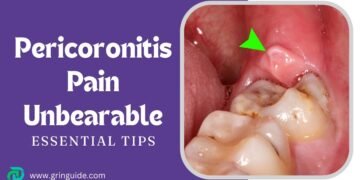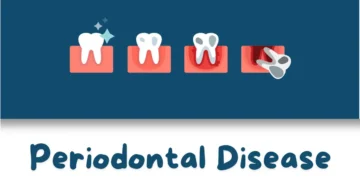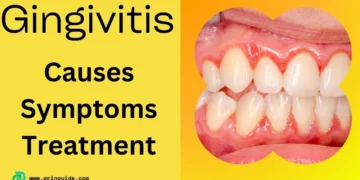Table of Contents
Introduction
Dental plaque is a sticky, colorless film that forms on the teeth and gums. It is primarily composed of bacteria, saliva, and food particles. While many people perceive dental plaque as merely a cosmetic issue, it is actually a leading factor in various oral health problems.
In this blog post, we will delve into the true nature of dental plaque and its impact on oral health. We will explore the misconceptions surrounding plaque and highlight its significance in causing dental issues.
By understanding the role of dental plaque, we can take proactive measures to maintain optimal oral hygiene.
Composition of Dental Plaque as a Biofilm
Dental plaque is classified as a biofilm, which is a community of microorganisms that adhere to a surface and form a protective matrix. In the case of dental plaque, the biofilm consists of bacteria, both harmful and beneficial, along with other components.
The main component of dental plaque is bacteria, which can vary in species and quantity from person to person. Some of the most common bacteria found in plaque include Streptococcus mutans, Actinomyces, and Porphyromonas gingivalis.

These bacteria thrive in the oral cavity, especially in areas that are difficult to clean, such as the spaces between teeth and along the gumline.
In addition to bacteria, dental plaque also contains food particles and saliva. When we consume food and beverages, small particles get trapped in the plaque, providing a source of nutrients for the bacteria. Saliva helps to moisten the plaque and facilitate bacterial growth.
How Plaque Forms on Teeth
Plaque forms on teeth through a process called adhesion. Initially, the tooth surface is clean and smooth. However, as bacteria colonize the oral cavity, they start to attach to the tooth surface.
The bacteria produce sticky substances called extracellular polymeric substances (EPS), which help them adhere to the teeth and form a biofilm.
Once the initial layer of bacteria has attached to the tooth, more bacteria join and multiply, creating a thick layer of plaque. Over time, if not removed, this plaque can harden and turn into tartar or calculus, which is more difficult to remove and can only be done by a dental professional.
Detection and Diagnosis
Detecting and diagnosing plaque is crucial in preventing its harmful effects. Dental professionals play a vital role in identifying and diagnosing plaque-related conditions.
Visual Examination
One of the primary methods for detecting dental plaque is through visual examination. Dentists and dental hygienists carefully inspect the teeth and gums for signs of plaque buildup.
They look for the presence of a sticky, colorless film on the tooth surfaces and along the gumline. Visual examination allows dental professionals to identify areas where plaque has accumulated and assess the severity of the condition.
Disclosing Agents
In addition to visual examination, disclosing agents are often used to aid in the detection of plaque. These agents are usually in the form of a dye or solution that highlights areas of plaque buildup.
When applied to the teeth, the disclosing agent stains the plaque, making it more visible to the dental professional. This method helps in identifying areas that may have been missed during routine brushing and flossing.
The role of dental professionals in diagnosing plaque-related conditions is crucial. Through their expertise and knowledge, they can accurately assess the extent of plaque buildup and determine the appropriate course of action.
Prevention and Control
Preventing and controlling dental plaque is essential to maintain good oral health. Effective plaque control requires a combination of proper oral hygiene practices, regular dental check-ups, and making wise diet and lifestyle choices.
1. Brushing
Brushing your teeth at least twice a day is a fundamental step in plaque control. Use a soft-bristled toothbrush and a fluoride toothpaste to thoroughly clean all surfaces of your teeth.
Pay special attention to the gumline and areas where plaque tends to accumulate. Brushing helps remove plaque, bacteria, and food particles, preventing the formation of tartar.
2. Flossing
Flossing is an essential part of plaque control that should not be overlooked. It helps remove plaque and food debris from between the teeth and along the gumline, where a toothbrush cannot reach.
Regular flossing, at least once a day, helps prevent plaque buildup and reduces the risk of gum disease.
3. Regular Dental Check-Up
Regular dental check-up is crucial in preventing and controlling dental plaque. Dentists and dental hygienists can detect and remove any plaque or tartar buildup that may have been missed during regular oral hygiene practices.
They can also provide guidance on proper brushing and flossing techniques tailored to your specific needs.
4. Diet and Lifestyle Choices
The importance of diet and lifestyle choices in plaque prevention should not be underestimated. Limiting the consumption of sugary and acidic foods and beverages can help reduce plaque formation.
Opting for a balanced diet rich in fruits, vegetables, and whole grains promotes overall oral health. Additionally, avoiding tobacco products and excessive alcohol consumption contributes to plaque control and general well-being.
Treatment of Plaque-Induced Conditions
If plaque is not effectively controlled, it can lead to various oral health conditions, including gum disease, tooth decay, and bad breath. Treatment of plaque-induced conditions may involve professional interventions and, in severe cases, surgical intervention.
Professional Treatments
Professional dental treatments are often necessary to address plaque-related diseases. One common treatment is a deep cleaning procedure called scaling and root planing.
This process involves removing plaque and tartar from the tooth surfaces and below the gumline. It helps eliminate bacteria and promotes gum healing.
In some cases, dental professionals may prescribe medication to manage plaque-related conditions. Antimicrobial mouth rinses or gels can help reduce bacteria and control plaque buildup.
These medications are used in conjunction with regular oral hygiene practices to enhance plaque control.
Surgical Intervention
In severe cases where plaque-related conditions have progressed significantly, surgical intervention may be required. Gum surgery, such as flap surgery or bone grafting, may be necessary to treat advanced gum disease and restore oral health.
Dental professionals carefully assess the need for surgical intervention based on the individual’s condition and provide appropriate recommendations.
Natural Role of Plaque in the Mouth
Despite its negative reputation, plaque actually plays a natural role in the mouth. It acts as a protective barrier, preventing harmful bacteria from directly contacting the tooth surface.
The biofilm matrix helps to shield the bacteria from the host’s immune system and antimicrobial agents, allowing them to survive and thrive.
Furthermore, plaque helps to regulate the pH balance in the mouth. When we consume carbohydrates, the bacteria in plaque break them down and produce acids as byproducts.
These acids can lower the pH level in the mouth, making it more acidic. However, the biofilm matrix of plaque helps to buffer and neutralize these acids, preventing excessive demineralization of the tooth enamel.
Impact of Plaque on Oral Health
While plaque has a natural role in the mouth, its accumulation can have a detrimental impact on oral health. As plaque builds up on the teeth and along the gumline, it can lead to various dental issues.
One of the most common problems associated with plaque is tooth decay or cavities.
The bacteria in plaque produce acids that can erode the tooth enamel, leading to the formation of cavities. If left untreated, cavities can progress deeper into the tooth, causing pain and potential infection.
Plaque also plays a significant role in the development of gingivitis, which is the early stage of gum disease. The bacteria in plaque release toxins that irritate the gums, causing inflammation and bleeding.
If not addressed, gingivitis can progress to periodontitis, a more severe form of gum disease that can result in tooth loss.
Connection Between Plaque and Dental Issues
The connection between plaque and common dental issues like cavities and gingivitis is well-established. As plaque accumulates on the teeth and gums, the bacteria release acids and toxins that attack the tooth enamel and irritate the gums.
In the case of cavities, the acids produced by plaque bacteria demineralize the tooth enamel, creating a weakened spot. Over time, this can lead to the formation of a cavity.
Regular brushing and flossing, along with professional dental cleanings, can help remove plaque and prevent the development of cavities.
Gingivitis, on the other hand, occurs when plaque bacteria cause inflammation in the gums. The toxins released by the bacteria irritate the gum tissue, leading to redness, swelling, and bleeding.
Proper oral hygiene practices, such as brushing and flossing, along with regular visits to the dentist, can help control plaque accumulation and prevent gingivitis.
Potential for Plaque to Cause Periodontal Disease
If plaque is not effectively removed from the teeth and gums, it can progress to periodontal disease.
Periodontal disease, also known as gum disease, is a chronic inflammatory condition that affects the supporting structures of the teeth, including the gums, periodontal ligament, and alveolar bone.
As plaque accumulates and hardens into tartar, it creates a rough surface that further facilitates bacterial adhesion.
The bacteria release toxins that cause chronic inflammation in the gums, leading to the destruction of the supporting tissues. This can result in gum recession, bone loss, and eventually tooth loss if left untreated.
Periodontal disease is a serious condition that requires professional intervention.
In addition to regular dental cleanings, treatment may involve scaling and root planing to remove plaque and tartar below the gumline, as well as other periodontal procedures to restore the health of the gums and supporting structures.
Revolutionizing Plaque Management: Innovations and Future Possibilities
While regular brushing and flossing are essential for plaque control, there are certain areas in the mouth that are difficult to reach and clean effectively.
This is where innovations in plaque management come into play, offering new solutions to improve oral hygiene and reduce the risk of dental issues.
Advancements in Plaque Detection
One of the key areas of innovation in plaque management is the development of new technologies for plaque detection.
Traditional methods, such as visual examination and probing, have limitations in identifying plaque in hard-to-reach areas. However, emerging technologies are now making it easier to detect and monitor plaque buildup.
One such innovation is the use of fluorescent dyes that can selectively bind to plaque bacteria. These dyes are applied to the teeth and illuminated with a special light, allowing dental professionals to visualize the presence and extent of plaque.
This non-invasive technique provides a more accurate assessment of plaque levels and helps in determining the effectiveness of oral hygiene practices.
Another promising advancement is the use of imaging techniques, such as optical coherence tomography (OCT), to detect and monitor plaque.
OCT uses light waves to create high-resolution cross-sectional images of the teeth and gums. By analyzing these images, dentists can identify areas of plaque buildup and assess the overall oral health of the patient.
Innovative Plaque Removal Techniques
In addition to plaque detection, there have been significant advancements in plaque removal techniques. While regular brushing and flossing remain the foundation of oral hygiene, new products and treatments are being introduced to enhance plaque control.
One notable innovation is the development of electric toothbrushes with advanced features. These toothbrushes often incorporate sonic or ultrasonic technology, which creates high-frequency vibrations to dislodge plaque and bacteria from the teeth and gums.
The bristle design and motion of these toothbrushes help in reaching areas that are difficult to clean with manual brushing alone.
Another breakthrough in plaque removal is the use of air polishing devices. These devices use a combination of compressed air, water, and fine powder particles to gently remove plaque and stains from the tooth surface.
Air polishing is particularly effective in cleaning hard-to-reach areas, such as around orthodontic brackets or dental implants.
Furthermore, advancements in dental materials have led to the development of antimicrobial agents that can be incorporated into toothpaste, mouth rinses, and dental floss. These agents help in reducing the growth of plaque bacteria and maintaining a cleaner oral environment.
The Future of Plaque Control
Looking ahead, the future of plaque control holds even more exciting possibilities. Researchers are exploring the use of nanotechnology to develop innovative solutions for plaque detection and removal.
One area of interest is the development of smart dental materials that can actively combat plaque formation. These materials may release antimicrobial agents or employ surface modifications to prevent the attachment of bacteria and plaque.
By incorporating these materials into dental restorations or orthodontic appliances, it may be possible to reduce the risk of plaque-related complications.
Additionally, researchers are investigating the potential of targeted drug delivery systems for plaque control. These systems would deliver antimicrobial agents or enzymes specifically to areas of plaque buildup, maximizing their effectiveness and minimizing side effects.
Furthermore, advancements in genetic research may pave the way for personalized plaque management. By analyzing an individual’s genetic profile, it may be possible to identify specific genetic markers associated with increased plaque formation.
This information could then be used to tailor preventive strategies and treatment approaches to each individual’s unique needs.
In conclusion
Dental plaque is a biofilm composed of bacteria, food particles, and saliva that forms on the teeth and gums. While plaque has a natural role in the mouth, its accumulation can lead to various oral health issues, including cavities, gingivitis, and periodontal disease.
Regular brushing, flossing, and professional dental cleanings are essential for preventing plaque buildup and maintaining optimal oral health.
detecting and diagnosing dental plaque is essential in preventing its harmful effects. Dental professionals play a crucial role in identifying and diagnosing plaque-related conditions through visual examination and the use of disclosing agents.
Professional treatments, such as deep cleaning and medication, are available to address plaque-induced conditions. In severe cases, surgical intervention may be necessary.
By understanding the importance of plaque prevention, detection, and treatment, individuals can maintain optimal oral health and prevent the progression of plaque-related diseases.
FAQs
-
What is Dental Plaque?
Dental plaque is a sticky, colorless film that forms on the teeth and along the gumline. It is composed of bacteria, food particles, and saliva. Plaque buildup is a natural process that occurs throughout the day, but if it is not properly removed, it can lead to various dental problems.
-
How does Dental Plaque Form?
Dental plaque forms when the bacteria in your mouth combine with the sugars and starches from the food you eat. This combination produces acids that attack the tooth enamel, leading to tooth decay and cavities. If plaque is not removed, it can harden and turn into tartar, which is more difficult to remove and can cause gum disease.








